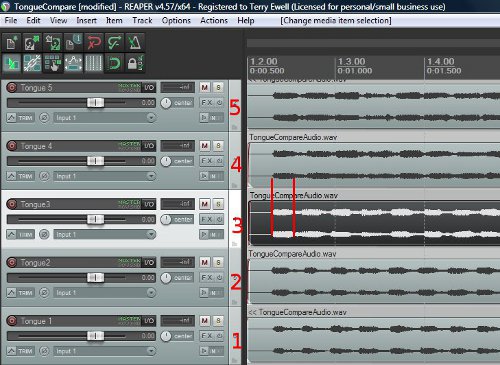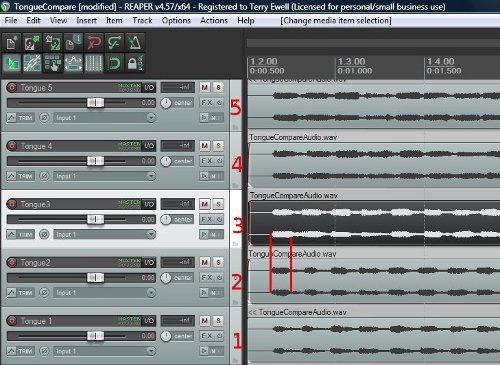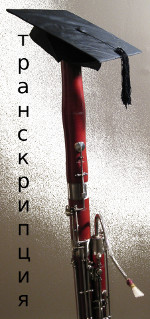Practicing Weissenborn Study #30
Weissenborn Opus 8/2, Study #30 for advanced bassoon students.
Discussion of the separation of tone production components for
articulation lengths 1-5. The third discussion on tuning (bassoon
registers). By Terry B. Ewell, Bassoon Digital Professor. Translated by
Elena Iakovleva. BDP#138. www.2reed.net.
Изучение этюда Nº 30.
Вайсенборн опус 8/2, этюд №30 для продвинутых студентов фаготистов.
Обсуждение о разделение компонентов звукоизвлечение, для артикуляции
1-5. Третье обсуждение насчет интонации (регистры фагота).Терри Б.
Юэлл, Цифровой Профессор Фагота. Перевод, Елена Яковлева. BDP # 138.
www.2reed.net.
TUTORIAL Руководство
1. Welcome, this is Terry Ewell. I think if Weissenborn had ever heard a tango, he would have written something like this:
1. Добро пожаловать, это Терри Юэлл. Я думаю, что если бы
Вайссенборн когда-либо услышал танго, он написал бы что-то вроде этого:
2. I can’t help but hear a Tango when I play certain portions of
this study! Sorry, I now think you will be imagining the same thing too.
2. Я не могу не услышать танго, когда я играю некоторые части этого этюда! Извините, я думаю что теперь, вы представите то же самое.
3. There is a tendency to rush during the staccato eighth notes in line
3. Unfortunately I amply demonstrated this rushing in my recording of
the study!
3. Бывает тенденция ускорять на восьмых нотах стаккато в 3й строчке.
К сожалению, я наглядно продемонстрировал это стремительное ускорять в
своей записи этого этюда!
4. Another rhythmic problem in the study is found with the three
slurred notes. The tendency is to rush those as well. Don’t play
them like this:
4. Другая обычная ритмическая проблема в этом этюде находится в трех залигованых нотах. Тенденция их тоже спешить. Не играйте их так:

5. Instead keep an accurate rhythm
5. Вместо этого исполняйте ритм точно.
6. In line 4 you can play Eb4 with just the G key. You might find this
easier, and certainly it makes for a better D4-Eb4 trill.
6. В 4й строчке вы можете сыграть Ми b4 только клапаном Соль. Это может оказаться вам проще, и, конечно, это поможет улучшить трель Ре4-Ми b4.
7. Now let’s work some more on our control of the air and tongue. Let’s first slur all the notes in the descending 3rds in line 3. Pay close attention to the way in which you phrase the notes. Create a full phrase with these notes. Shape the notes with your air, “the wind.”
7. Теперь давайте немного поработаем над контролем воздуха и языка. Давайте сначала залигуем все ноты в нисходящих терциях в 3й строчке. Обратите особое внимание на то, как вы фразируете ноты. Создайте полную фразу этими нотами. Сформируйте ноты своим воздухом, «ветром».

8. Now without changing the beautiful shape you made with the air let’s make different lengths of articulation. In Weissenborn study #7 I introduced a scaling of articulations from 1 to 5.
8. Теперь, не меняя красивую форму, которую вы создали с помощью воздуха, давайте сыграем другую длину артикуляции. В этюде Вайссенборна № 7 я ввел шкалу артикуляции от 1 до 5.
9. We will practice with those same articulations here.
Here is length number 5.
Here is length number 5.
10. Notice that component 1 (breath) and component 5 (embouchure) work just as they did when I slurred the example. The length of notes is determined by the amount of time the tongue (component 4) is on the reed, not by a change in the other components. For length number 5 the tongue touches the reed as little as possible.
10. Обратите внимание, что компонент номер 1 (дыхание) и компонент номер 5 (амбушюр) работают так же, как они работали, когда я залиговал этот пассаж. Длина нот определяется количеством времени, в течение которого язык (компонент номер 4) находится на трости, а не изменением других компонентов. Для длины номер 5 язык касается трости как можно меньше.
11. Here is length number 4
11. Вот длина номер 4
12. Here is length number 3
12. Aquí está el número 3.
13. Here is length number 2
13. Вот длина номер 2
14. And here are the shortest notes, length number 1
14. А вот и самые короткие ноты, длина номер 1
15. I realize that it may be difficult for you to hear the differences,
so let’s take a look at the sound waves. Here I am using a
software program called Reaper.
15. Я понимаю, что вам может быть трудно услышать разницу, поэтому давайте посмотрим на звуковые волны. Здесь я использую компьютерную программу под названием Reaper.
16. Let’s see how well I did differentiating the note lengths. You can see a difference between lengths 5 and 4. The difference between 3 and 4 is more difficult to see partly because I didn’t play the two at the same speed. It looks like the later notes are indeed shorter in 3 than in 4. The differences in note lengths between 2 and 3 and 1 and 2 are distinct.
16. Давайте посмотрим, насколько хорошо я различил длительности нот. Вы можете увидеть разницу между длительностями номер 5 и 4. Разницу между номерами 3 и 4 труднее увидеть частично, потому что я их сыграл с разными скоростями. Похоже, что последние ноты действительно стали короче в номере 3, чем в номере 4. Различия в длине нот между номерам 2 и 3 и 1 и 2 хорошо видны.




17. Only by separating the five components from one another and
allowing them to operate independently can I achieve this variety of
articulation. If my embouchure or the jaw tries to articulate, it will
only impede the variety I can achieve with the tongue at a variety of
tempos.
17. Только отделяя пять компонентов друг от друга и позволяя им работать независимо, я могу достичь такого разнообразия артикуляции. Если мой амбушюр или челюсть попытаются артикулировать, это только помешает тому разнообразию, которого я могу достичь с помощью языка в разных темпах.
18. Practice with all five articulations and see if you can gain
further mastery. In the actual study I would choose to play the short
notes at a number 2 or 3 in length.
18. Занимайтесь всеми пятью видами артикуляции и посмотрите, сможете ли вы достать мастерства. В этюде я бы предпочел играть короткие ноты длительностями номер 2 или 3.
19. I realize in my performance of the study I do move my jaw with the articulations in that passage. Jaw movements do allow for some shaping of the staccato notes.
19. Я понимаю, что, когда я играю этот этюд, я двигаю челюстью когда артикулирую этот пассаж. Движения челюсти разрешают формировать ноты staccato.
20. However, my experience is that jaw movement when coordinated with tonguing is limited to the middle range of articulation numbers. It works with articulation numbers 2 or 3, but will not work well with articulations 5, 4, and 1. My point is that for the greatest variety of articulations you need to minimize or remove entirely the motion of the jaw or embouchure.
20. Однако мой опыт показывает, что движение челюсти при координации с языком ограничено средним участком номеров артикуляции. Оно работает с артикуляцией номер 2 или 3, но не будет хорошо работать с артикуляцией 5, 4 и 1. Я хочу сказать, что для наибольшего разнообразия артикуляцией вам нужно минимизировать или полностью устранить движение челюсти или амбушюра.
REFLECTION Размышление
21. This is the third part of our discussion of intonation on the bassoon. In this reflection I draw upon material I presented in an article published in the Double Reed journal:
21. Это третья часть нашего обсуждения интонации на фаготе. В этом размышлении я опираюсь на материал, который я представил в статье, опубликованной в журнале «Double Reed»:
- "Teaching the Beginning Bassoonist," The Double Reed 23/2 (2000): 35-43.
http://www.2reed.net/EwellArticles/BeginningBassoonist_DR23_2.pdf

22. There are three registers on the bassoon. In general there is a progression from sharper notes at the bottom of the registers to more neutral notes in the middle and then towards flatter notes at the top of the registers. The second register’s progressions through the vowels are more rapid than the first register. The pitches tendencies are rather wild and uneven in the third register.
22. На фаготе есть три регистра. В целом, наблюдается переход от более завышенных нот в нижней части регистров к более нейтральным нотам в середине, а затем к заниженным нотам в верхней части регистров. Во втором регистре переход через гласные происходит быстрее, чем в первом регистре. Тенденции довольно дикие и неравномерные в третьем регистре.
23. Moving between registers requires a rapid vowel shift. For instance, movement from E3 to F3 requires a quick shift from “ee” to “ah to properly tune the notes.
23. Перемещение между регистрами требует быстрого изменения гласных. Например, переход от E3 до F3 требует быстрого перехода от «и» на «а», чтобы правильно настроить ноты.
24. Carefully experiment with other aspects of these registers. Mastering intonation on the bassoon requires that you understand these pitch tendencies on the instrument. Practicing scales and arpeggios with drones is a great way to gain mastery with intonation.
24. Тщательно по экспериментируйте с другими аспектами этих регистров. Овладение интонацией на фаготе требует, чтобы вы понимали эти тенденции высоты нот на инструменте. Занятие гаммами и арпеджио с помощью дронов - отличный способ овладеть интонацией.
http://www.2reed.net/2_drones.html
25. I will be explaining more about tuning and crossing over a register break in Weissenborn study #32.25. Я буду подробнее говорить об интонации и о переходе с одного регистра в другой, в этюде Вайссенборна № 32.
Note on F3:
Acoustically F3 is the top note of the fundamental range of the
bassoon, the upper most note of the first register. However, F3 is
quite sharp on Heckel bassoons, and for this reason I am grouping it
with the second register. It requires a vowel type closer to F#3 than
E3. Your bassoon may be different.
Заметка насчет Фа 3:
Акустически F3 - верхняя нота основного диапазона фагота, самая верхняя
нота первого регистра. Тем не менее, Фа 3 довольно высокий на фаготах
Heckel, и по этой причине я группирую его со вторым регистром. Он
требует тип гласной ближе к Фа # 3, чем Ми 3. Ваш фагот может быть
другим.
